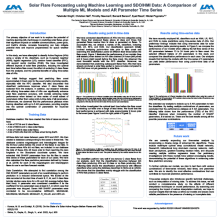Solar Flare Forecasting using Machine Learning and SDO/HMI Data: A Comparison of Multiple ML Models and AR Parameter Time Series
Talwinder
Singh
University of Alabama in Huntsville
Poster
Solar flares are explosive events that release massive amounts of energy, particles, and radiation into the space environment. Accurate forecasting of these events is crucial for space weather prediction and mitigation efforts. In this presentation, we will discuss the results of our study on solar flare forecasting using machine learning (ML) models and SDO/HMI data. We will compare the performance of multiple ML models, including K-Nearest Neighbors (KNN), Random Forest Classifier (RFC), Logistic Regression (LR), and Support Vector Machines (SVM), in predicting solar flares. Additionally, we will examine the difference in forecasting accuracy between Active Regions (ARs) that have flared before and ARs that have not flared yet.
Furthermore, we will show the improvement in forecasting metrics when a time series of AR parameters is used in training instead of point in time parameters. Specifically, we will investigate the use of AR parameters such as magnetic field strength, area, and complexity as features in our ML models. We will also discuss the potential of this approach to improve the overall accuracy of solar flare forecasting. Our study provides insights into the effectiveness of ML models for solar flare forecasting and the importance of AR parameter time series in improving the accuracy of such forecasts.
Furthermore, we will show the improvement in forecasting metrics when a time series of AR parameters is used in training instead of point in time parameters. Specifically, we will investigate the use of AR parameters such as magnetic field strength, area, and complexity as features in our ML models. We will also discuss the potential of this approach to improve the overall accuracy of solar flare forecasting. Our study provides insights into the effectiveness of ML models for solar flare forecasting and the importance of AR parameter time series in improving the accuracy of such forecasts.

Poster PDF
Poster category
Solar and Interplanetary Research and Applications
Meeting homepage